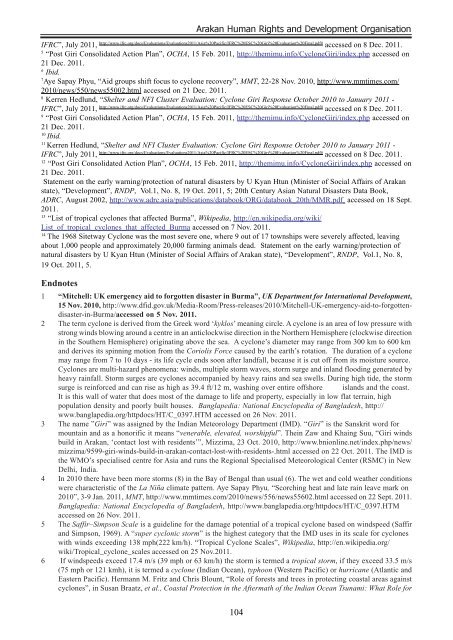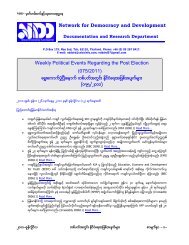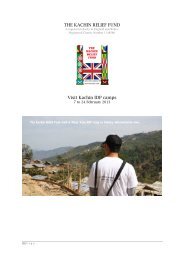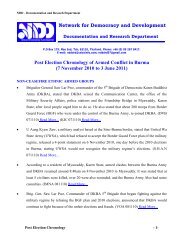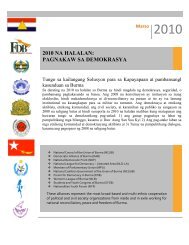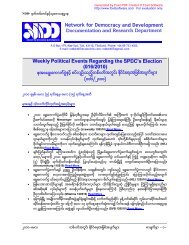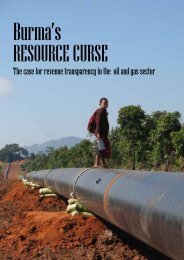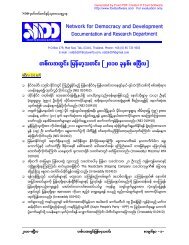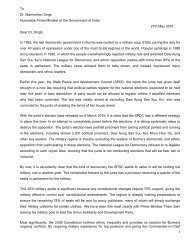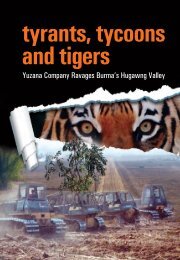Cyclone Giri - Two Years On - Burma Action Ireland
Cyclone Giri - Two Years On - Burma Action Ireland
Cyclone Giri - Two Years On - Burma Action Ireland
Create successful ePaper yourself
Turn your PDF publications into a flip-book with our unique Google optimized e-Paper software.
Arakan Human Rights and Development Organisation<br />
IFRC”, July 2011, http://www.ifrc.org/docs/Evaluations/Evaluations2011/Asia%20Pacific/IFRC%20ESC%20<strong>Giri</strong>%20Evaluation%20Final.pdf# accessed on 8 Dec. 2011.<br />
5<br />
“Post <strong>Giri</strong> Consolidated <strong>Action</strong> Plan”, OCHA, 15 Feb. 2011, http://themimu.info/<strong>Cyclone</strong><strong>Giri</strong>/index.php accessed on<br />
21 Dec. 2011.<br />
6<br />
Ibid.<br />
7<br />
Aye Sapay Phyu, “Aid groups shift focus to cyclone recovery”, MMT, 22-28 Nov. 2010, http://www.mmtimes.com/<br />
2010/news/550/news55002.html accessed on 21 Dec. 2011.<br />
8<br />
Kerren Hedlund, “Shelter and NFI Cluster Evaluation: <strong>Cyclone</strong> <strong>Giri</strong> Response October 2010 to January 2011 -<br />
IFRC”, July 2011, http://www.ifrc.org/docs/Evaluations/Evaluations2011/Asia%20Pacific/IFRC%20ESC%20<strong>Giri</strong>%20Evaluation%20Final.pdf# accessed on 8 Dec. 2011.<br />
9<br />
“Post <strong>Giri</strong> Consolidated <strong>Action</strong> Plan”, OCHA, 15 Feb. 2011, http://themimu.info/<strong>Cyclone</strong><strong>Giri</strong>/index.php accessed on<br />
21 Dec. 2011.<br />
10<br />
Ibid.<br />
11<br />
Kerren Hedlund, “Shelter and NFI Cluster Evaluation: <strong>Cyclone</strong> <strong>Giri</strong> Response October 2010 to January 2011 -<br />
IFRC”, July 2011, http://www.ifrc.org/docs/Evaluations/Evaluations2011/Asia%20Pacific/IFRC%20ESC%20<strong>Giri</strong>%20Evaluation%20Final.pdf# accessed on 8 Dec. 2011.<br />
12<br />
“Post <strong>Giri</strong> Consolidated <strong>Action</strong> Plan”, OCHA, 15 Feb. 2011, http://themimu.info/<strong>Cyclone</strong><strong>Giri</strong>/index.php accessed on<br />
21 Dec. 2011.<br />
Statement on the early warning/protection of natural disasters by U Kyan Htun (Minister of Social Affairs of Arakan<br />
state), “Development”, RNDP, Vol.1, No. 8, 19 Oct. 2011, 5; 20th Century Asian Natural Disasters Data Book,<br />
ADRC, August 2002, http://www.adrc.asia/publications/databook/ORG/databook_20th/MMR.pdf accessed on 18 Sept.<br />
2011.<br />
13<br />
“List of tropical cyclones that affected <strong>Burma</strong>”, Wikipedia, http://en.wikipedia.org/wiki/<br />
List_of_tropical_cyclones_that_affected_<strong>Burma</strong> accessed on 7 Nov. 2011.<br />
14<br />
The 1968 Sitetway <strong>Cyclone</strong> was the most severe one, where 9 out of 17 townships were severely affected, leaving<br />
about 1,000 people and approximately 20,000 farming animals dead. Statement on the early warning/protection of<br />
natural disasters by U Kyan Htun (Minister of Social Affairs of Arakan state), “Development”, RNDP, Vol.1, No. 8,<br />
19 Oct. 2011, 5.<br />
Endnotes<br />
1 “Mitchell: UK emergency aid to forgotten disaster in <strong>Burma</strong>”, UK Department for International Development,<br />
15 Nov. 2010, http://www.dfid.gov.uk/Media-Room/Press-releases/2010/Mitchell-UK-emergency-aid-to-forgottendisaster-in-<strong>Burma</strong>/accessed<br />
on 5 Nov. 2011.<br />
2 The term cyclone is derived from the Greek word ‘kyklos’ meaning circle. A cyclone is an area of low pressure with<br />
strong winds blowing around a centre in an anticlockwise direction in the Northern Hemisphere (clockwise direction<br />
in the Southern Hemisphere) originating above the sea. A cyclone’s diameter may range from 300 km to 600 km<br />
and derives its spinning motion from the Coriolis Force caused by the earth’s rotation. The duration of a cyclone<br />
may range from 7 to 10 days - its life cycle ends soon after landfall, because it is cut off from its moisture source.<br />
<strong>Cyclone</strong>s are multi-hazard phenomena: winds, multiple storm waves, storm surge and inland flooding generated by<br />
heavy rainfall. Storm surges are cyclones accompanied by heavy rains and sea swells. During high tide, the storm<br />
surge is reinforced and can rise as high as 39.4 ft/12 m, washing over entire offshore islands and the coast.<br />
It is this wall of water that does most of the damage to life and property, especially in low flat terrain, high<br />
population density and poorly built houses. Banglapedia: National Encyclopedia of Bangladesh, http://<br />
www.banglapedia.org/httpdocs/HT/C_0397.HTM accessed on 26 Nov. 2011.<br />
3 The name ”<strong>Giri</strong>” was assigned by the Indian Meteorology Department (IMD). “<strong>Giri</strong>” is the Sanskrit word for<br />
mountain and as a honorific it means “venerable, elevated, worshipful”. Thein Zaw and Khaing Suu, “<strong>Giri</strong> winds<br />
build in Arakan, ‘contact lost with residents’”, Mizzima, 23 Oct. 2010, http://www.bnionline.net/index.php/news/<br />
mizzima/9599-giri-winds-build-in-arakan-contact-lost-with-residents-.html accessed on 22 Oct. 2011. The IMD is<br />
the WMO’s specialised centre for Asia and runs the Regional Specialised Meteorological Center (RSMC) in New<br />
Delhi, India.<br />
4 In 2010 there have been more storms (8) in the Bay of Bengal than usual (6). The wet and cold weather conditions<br />
were characteristic of the La Niña climate pattern. Aye Sapay Phyu, “Scorching heat and late rain leave mark on<br />
2010”, 3-9 Jan. 2011, MMT, http://www.mmtimes.com/2010/news/556/news55602.html accessed on 22 Sept. 2011.<br />
Banglapedia: National Encyclopedia of Bangladesh, http://www.banglapedia.org/httpdocs/HT/C_0397.HTM<br />
accessed on 26 Nov. 2011.<br />
5 The Saffir–Simpson Scale is a guideline for the damage potential of a tropical cyclone based on windspeed (Saffir<br />
and Simpson, 1969). A “super cyclonic storm” is the highest category that the IMD uses in its scale for cyclones<br />
with winds exceeding 138 mph(222 km/h). “Tropical <strong>Cyclone</strong> Scales”, Wikipedia, http://en.wikipedia.org/<br />
wiki/Tropical_cyclone_scales accessed on 25 Nov.2011.<br />
6 If windspeeds exceed 17.4 m/s (39 mph or 63 km/h) the storm is termed a tropical storm, if they exceed 33.5 m/s<br />
(75 mph or 121 kmh), it is termed a cyclone (Indian Ocean), typhoon (Western Pacific) or hurricane (Atlantic and<br />
Eastern Pacific). Hermann M. Fritz and Chris Blount, “Role of forests and trees in protecting coastal areas against<br />
cyclones”, in Susan Braatz, et al., Coastal Protection in the Aftermath of the Indian Ocean Tsunami: What Role for<br />
104


